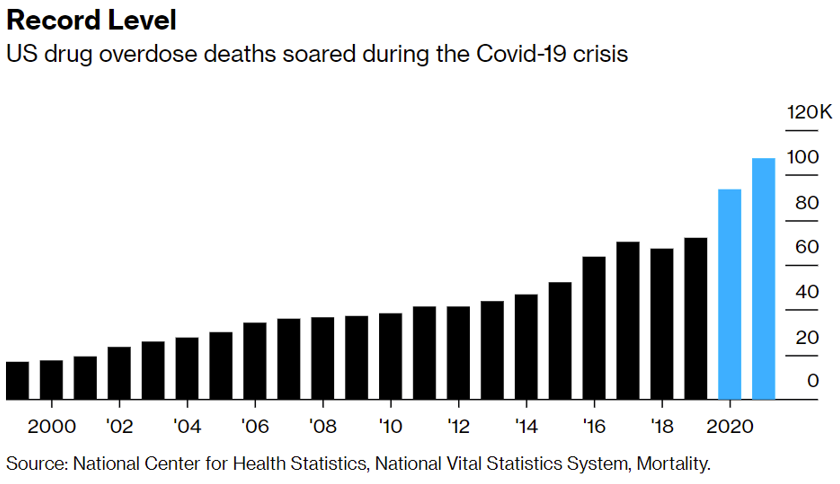TAKE 3 W/ SLP, May 2022
NOTE: Sober Linings Playbook is a personal website. Any views or opinions expressed herein belong solely to the website owner and do not represent those of individuals or organizations the owner may be associated with in a professional or personal capacity, unless explicitly stated.
“Take 3 w/SLP” is Sober Linings Playbook’s monthly summary of three stories we think deserve a closer look. Along with a bit of commentary, we include links to additional resources for readers interested in learning more about the topics. “Take 3” is also a monthly segment on the Recovery in the Middle Ages podcast. Look for it on the last Friday of the month wherever you find podcasts.
The three topics this month are:
Recovery High Schools;
National Fentanyl Awareness Day (May 10); and
Online addiction treatment locator platforms.
One. Recovery High Schools
They say one of the keys to recovery - particularly in the early days - is to “change people, places and things.” But when school is compulsory, and when drinking and drug use revolve around school peers and school-related activities, it’s not so easy to make those changes. That’s why the recovery school concept is so compelling.
I first became aware of recovery high schools when I listened to a Feb. 2022 episode of the Heart of the Matter podcast hosed by Elizabeth Vargas (“Radical compassion and the power of empathy: in the halls with the students of Northshore Recovery High School”). The focus of the podcast episode was a school that had been featured on an MTV series called “16 and Recovering.” I have not seen the MTV series, but the podcast is worth a listen.
Earlier this month, I included a story about a recovery high school in Virginia (“Addiction recovery high school could open this fall for Central Virginia students”) in the Wednesday Weekly news clips. One reader left a comment to thank me for including the article and to ask whether there are other recovery high schools in the U.S. I didn’t have an answer. In fact, I didn’t know much about recovery high schools at all. I decided to take a closer look.
The Association of Recovery Schools (ARS) website reports that recovery high schools are secondary schools designed specifically for students in recovery from substance use or co-occurring disorders.” According to ARS, there may be some differences in the way they operate, but their primary purpose is to educate students in recovery.
Based on information on the ARS website, recovery schools must meet state requirements for awarding a diploma. Students enrolled in the schools must be “working a program of recovery from substance use or co-occurring disorders as determined by the student and the school.” The schools have the same staff as any other school, but also employ substance use disorder and mental health counselors. The 43 schools listed on the ARS website appear to be a mixture of private and publicly-funded recovery schools. Some are stand-alone entities. Others operate as schools within existing schools.
A 2019 TIME magazine article (“Inside the Specialized 'Recovery' High Schools Designed Just for Teens With Addiction,” Jan. 23, 2019) reports on research indicating recovery schools are effective both at keeping students from drinking and using drugs, and at keeping them in class. The article points to a 2017 study that found students in recovery schools were more likely than students in other schools to report abstinence from alcohol and drugs and fewer absences from school.
In the TIME article, recovery school students reported encountering fewer temptations than at traditional high schools. Experts quoted in the article cite association with sober peers, and access to teachers and counselors who support recovery, as factors that contribute to the success of students in recovery schools. As the opioid epidemic continues, and the death toll from the fentanyl-fueled overdose crisis continues to rise, I think a case could be made that it’s time to test the recovery school concept on a broader scale.
If you’re like me, you’re probably wondering “what about college?” Looking back at my undergrad years at the University of Wisconsin, it’s clear to me that college life is often not very conducive to recovery. As it turns out, there are collegiate recovery programs as well.
According to a 2006 journal article (“The Recovery School Movement: Its History and Future ”), the recovery school concept actually began at the college level with Brown and Rutgers universities adopting programs in the late 1970s and early 1980s. The Association of Recovery in Higher Education (ARHE), which represents collegiate recovery programs (CRPs) and communities (CRCs), lists well over 100 members in its 2020 Impact Report.
As a parent of two kids in college, I know there are a lot of factors prospective students and their families weigh in making the decision of where to go to school. For some students, the availability of recovery resources might help tip the balance.
For more on collegiate recovery programs, check out these resources:
Finding a Home in Collegiate Recovery, by Timothy Rabolt
As a student in early recovery, I felt that the college experience was an impossible uphill climb where I would be met with drugs and alcohol everywhere I turned. Finding a collegiate recovery program (CRP) gave me a path I never thought possible.
Partnership to End Addiction Blog – Sept. 2019
Kennesaw State University offers addiction recovery program to students
For the past 15 years, Kennesaw State’s Center for Young Adult Addiction and Recovery (CYAAR) has been providing students who have a history of substance use disorders with a recovery-friendly community that fosters education and well-being.
11Alive Local News – May 2, 2022
Two. Fentanyl Awareness Day (May 10, 2022)
To increase awareness of the deadly fentanyl crisis, the U.S. Drug Enforcement Administration recognized the first-ever National Fentanyl Awareness Day on May 10, 2022. A DEA press release reported that the purpose of the event was to partner with other law enforcement, public health and non-profit organizations to provide education about the danger the powerful synthetic opioid poses to the “safety, health and national security of the American people.”
DEA Administrator Anne Milgram highlights the dangers of fentanyl and the need for action.
Coinciding with Fentanyl Awareness Day was the CDC’s announcement that the pandemic surge of overdose deaths continued in 2021 (see, for example, “In 2021, US drug overdose deaths hit highest level on record, CDC data shows,” CNN, May 11, 2022). From 2019 to 2020 there was a nearly 30 percent increase from about 70,000 to 90,000 overdose deaths. From 2020 to 2021, the U.S. saw a 15 percent increase to just over 107,000.
From “US Overdose Deaths Soared 15% to Top 100,000 Last Year, CDC Says,” Bloomberg, May 11, 2022.
The public policy response to fentanyl generally falls into the categories of harm reduction (efforts aimed at reducing the likelihood of overdose deaths among drug users) or law enforcement (cracking down to reduce supply or stiffening penalties to deter possession and sales).
A May 4, 2022 CNN article notes that more states are making fentanyl test strips – often classified under criminal statutes as illegal drug paraphernalia – legal (“More states allow fentanyl test strips as a tool to prevent overdoses”). But even as support for harm reduction appears to be growing, some states are also cracking down on fentanyl with stepped up enforcement and stiffer penalties for dealers. (For example, see “State Laws Are Treating Fentanyl Like the New Crack—And Making the Same Mistakes of the 80s and 90s,” TIME, May 12, 2022).
In recent months, I’ve noticed a narrative shift in the how unintentional fentanyl-related deaths are described. More and more, advocates and journalists are replacing “overdose” with the less-stigmatizing “poisoning.” In a recent Colorado Public Radio interview, (“Gov. Jared Polis calls fentanyl a ‘poison,’ says he wants stiffer possession penalties,” CPR, April 19, 2022) the Centennial State’s Governor refers to fentanyl as a “poison” in his comments urging stiffer penalties for possession.
Regardless of how one feels about the extent to which we should focus resources on harm reduction or law enforcement efforts, I think many of us can probably agree that deaths resulting from unwitting use of fentanyl can be accurately described as poisonings.
Three. Addiction Treatment Locators.
A recent Kaiser Health News article (“National Addiction Treatment Locator Has Outdated Data and Other Critical Flaws,” May 9, 2022) reported concerns about the U.S. Substance Abuse and Mental Health Services Administration’s (SAMHSA’s) FindTreatment.gov website.
“FindTreatment.gov” was launched in 2019 as a directory of state-licensed programs developed to help people find treatment for substance use disorders (SUDs). According to the Kaiser article, concerns have been raised about how accurate and current the information is, and about the website’s lack of guidance for consumers on how to assess treatment quality.
The Kaiser article also reports that the nonprofit organization, Shatterproof, has developed an online tool called the Addiction Treatment Locator Assessment and Standards (ATLAS) platform. ATLAS is currently available in six states. Shatterproof is working to expand the platform to other states.
ATLAS includes self-reported data on quality measures such as whether treatment providers offer same-day appointments, provide medication assisted treatment (MAT) and offer long-term treatment and follow up. To provide consumers with guidance on identifying treatment options to meet their individual needs, the website also includes a treatment needs assessment survey developed in collaboration with the American Society of Addiction Medicine.
It can be difficult to make the decision to seek help for a substance use disorder. Once the decision is made, it should be easy for the individual to access information about the type of treatment that meets their needs and where to find it. For that reason, the work of creating and sustaining easily accessible, high-quality online treatment locators is vitally important.
__________
And that, my friends, is Take 3 with SLP. We’ll be back with more at a later date. Until then, stay tuned and keep current by reading the Wednesday Weekly news clips!
Sober Linings Playbook


